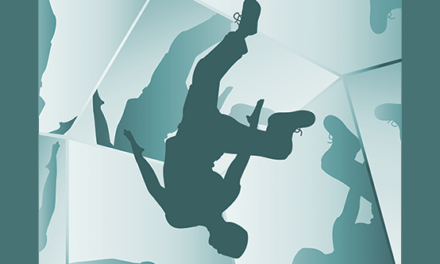
Integrating physical activity into elementary school lessons in reading, math, and other subjects can boost students’ academic learning, while also helping them meet goals for physical education.
Intuitively, many teachers have always known that physical activity plays an important role in student learning. However, educational researchers have only recently begun to take a close look at the effects of integrating gesture, dance, and other kinds of movement into the everyday life of the classroom. Early findings suggest that engaging students in such activities has positive effects on their motivation, engagement, and learning, while also helping them become more physically active overall.
Movement integration is an interdisciplinary method of teaching that provides effective instruction in two subject areas at once, leading students to achieve curricular goals in both academic and physical education (Brophy & Alleman, 1991). Recent studies have found that incorporating movement activities in the elementary classroom shows promise as a way to boost student interest, motivation (Vazou et al., 2012), and learning (Braniff, 2011). It has been found to lead to improvements in content knowledge, skills, and test scores in core subjects such as mathematics and reading fluency (Adams-Blair & Oliver, 2011; Erwin, Fedewa, & Ahn, 2013; Browning et al., 2014). Further, in an era when school time for designated physical activity and physical education has been reduced (Lee et al., 2007), such innovative strategies may be necessary to help children meet the recommendation that they engage in 60 minutes of physical activity every day.
Increasing student interest
Psychologists distinguish between personal and situational interest. Whereas personal interest builds and persists over time (Hidi & Renninger, 2006), situational interest refers to a person’s focused attention on stimuli at a particular moment, and it may or may not last beyond the given situation or activity (Hidi, 1990; Hidi & Baird, 1986). Greater levels of both kinds of student interest have been found to promote stronger attention, motivation, and content learning (Hidi & Renninger, 2006). In the classroom, however, situational interest is especially critical, as it permits the kind of sustained attention needed to grasp the knowledge, concepts, and skills at hand (Ainley, Hidi, & Berndorff, 2002).
In a recent research study, we sought to determine whether lessons that incorporated movement were particularly effective at generating students’ situational interest. Specifically, we compared the outcomes of movement and nonmovement lessons in 2nd- and 3rd-grade reading and math classes taught by four preservice teachers.
After being trained in the approach, the preservice teachers provided one week of lessons that included movement and one week of lessons that did not. They were also trained to rate students’ interest levels, both through direct observation and in retrospect, offered during the video sessions that they recorded following each lesson.
At times, movement was integrated into the teaching of the reading and math classes, at other times it influenced how the students applied the material, and at other times it was incorporated into student assessment. For example, the lessons in both the movement and nonmovement classes began in the same way, with the teacher explaining concepts though direct instruction. However, in some classes, students were asked to use their bodies to illustrate specific concepts, or they were taught a song that included hand motions and gestures and that was designed to help them remember a particular idea. In some classes, during the application portion of the lesson, students were asked to use their bodies to illustrate lines and angles in math, or they were asked to stand up and move into groups that represented linked concepts. And in order to assess students’ understanding, teachers asked students to use movements to indicate their answers to questions about the learned content.
Overall, we found that students were significantly more excited by, engaged in, and focused on the lessons that integrated movement than those that did not. Further, both the preservice teachers and their supervising teachers reported that students learned just as much content during the integrated movement lessons as during non-movement lessons.
Engaging students in physical activities has positive effects on their motivation, engagement, and learning.
Five strategies for integrating movement
To promote greater student interest and activity in the classroom, teachers may consider using a variety of strategies to integrate movement into their lessons. Though some strategies may be best for teaching a particular subject, others can be used in a number of courses. The following strategies were used in the research study and were effective in integrating movement and content learning.
STRATEGY #1:
Dancing to learn information
As teachers provide students with new information that must be memorized, one method to help students in retaining this information is to teach them a dance. Many teachers use songs to help students learn new information, so adding movements or dancing to the song provides an additional source of engagement. For example, when teaching students how to skip count, teachers can use the movements and rhythm from the song “Macarena” to help students count “five, 10, 15, 20” to the beat. Other well-known examples include a math dance (Wright, 2010), used to teach angles, and a grammar dance, in which students create and perform routines inspired by the parts of speech (UK: Grammar Dance, n.d.).
STRATEGY #2:
Applying movement to content assessment
When teaching applications of academic content, teachers can require students to associate the content with specific movements. For example, when they practice rounding numbers to the nearest 10, students can use jumping jacks to represent the number 10, hopping on one foot to represent 20, and so on — i.e., when the teacher calls out “18,” the students should all start hopping. Or, in English language arts, students can play a jumping game when practicing synonyms and antonyms: When the teacher says “go,” pairs of students jump straight up and down three times, then choose to land on either their right or left foot. If both choose to land on the same foot, then they must come up with synonyms for a word that the teacher has put on the board. If they land on opposite feet, then they must come up with antonyms.
STRATEGY #3:
Moving among stations around the room
To get students moving during a lesson, teachers can ask them to collect materials from around the room. Say, for example, that students are working in groups to learn about fractions. The teacher can give each group cards with fractions written on them, asking each member of the group to take their card to another table across the room to see if anybody in that group has a card with an equivalent fraction. If so, they can take it back to their table, checking with their own group to make sure the fractions are equivalent.
Or, for example, when teaching a spelling lesson about diphthongs (vowel combinations such as “-oi” and “-oy”), a teacher can assign students to teams, giving each a list of words that have had diphthongs removed. The teams can then search around the room looking for cards printed with diphthongs that will complete their words. (To get them moving a bit more, the teacher can ask students to move across the room in certain ways, such as by using baby steps or walking on tiptoe.)
STRATEGY #4:
Ordering and organizing
To better understand the order of concepts in math or reading, teachers can have students organize themselves into lines, rows, or other groupings. For example, the teacher can hand out cards printed with a fraction or decimal, asking students to arrange themselves in order from the least to greatest value represented on their cards. Or, in reading class, each student might get a card that has a word or punctuation mark on it; the challenge is for the students to arrange themselves to form a complete sentence. (To add a layer of difficulty, teachers can also ask students to remain silent while doing these activities, using hand motions, eye movements, or even hops and jumps to signal to each other to move backward or forward in line.)
STRATEGY #5:
Representing with actions
Students can also use their bodies to represent key academic terms and ideas, as well as to demonstrate their understanding of those ideas. In math class, for example, the teacher might ask a group of students to lie down on the carpet in the shape of an acute angle or a trapezoid. Or, after reading a book about emotions, students might be asked to stand and act out the new words they’ve just learned, such as “satisfied,” “furious,” and “courageous.” Younger children, especially, may benefit from using movements to help them grasp the basics of reading and math. During story time, for example, they might be asked to stomp their feet, representing a period, every time the teacher reaches the end of a sentence. Or, when learning to add and subtract, they might be asked to hop forward or backward on a number line.
Closing thoughts
Movement integration is an interdisciplinary method of teaching that incorporates physical activity into academic content areas, strengthening both kinds of learning, while also contributing to students’ recommended total of at least 60 minutes of daily physical activity (CDC, 2013). Although teachers may be hesitant at first about integrating movement into classroom lessons, the research described above (and see Braniff, 2011; Martin & Murtagh, 2015) suggests that it is not difficult for teachers to implement such practices, and when they do so, they tend to view these pedagogies more positively.
More important, research suggests that movement activities in the classroom have a positive influence on children’s overall physical activity and learning (Adams-Blair & Oliver, 2011; Erwin et al., 2011; Erwin, Fedewa, & Ahn, 2013) as well as boosting their interest levels, which supports greater sustained attention to lessons, allowing them to learn more effectively and commit concepts more easily to long-term memory (Hidi, 1990). In sum, the data provide strong support for the integration of movement lessons in the classroom, and the activities provided here may assist teachers in facilitating movement in their own classrooms.
References
Adams-Blair, H. & Oliver, G. (2011). Daily classroom movement: Physical activity integration into the classroom. International Journal of Health, Wellness, & Society, 1 (3), 147-154.
Ainley, M., Hidi, S., & Berndorff, D. (2002). Interest, learning, and the psychological processes that mediate their relationship. Journal of Educational Psychology, 94, 1-17.
Braniff, C. (2011). Perceptions of an active classroom: Exploration of movement and collaboration with fourth grade students. Networks: An On-line Journal for Teacher Research, 13 (1).
Brophy, J. & Alleman, J. (1991). A caveat: Curriculum integration isn’t always a good idea. Educational Leadership 49 (2), 66.
Browning, C., Edson, A.J., Kimani, P., & Aslan-Tutak, F. (2014). Mathematical content knowledge for teaching elementary mathematics: A focus on geometry and measurement. Mathematics Enthusiast, 11 (2), 333-383.
Centers for Disease Control and Prevention (CDC). (2013). Comprehensive physical activity programs: A guide for schools. Atlanta, GA: U.S. Department of Health and Human Services.
Erwin, H.E., Beighle, A., Morgan, C.F., & Noland, M. (2011). Effect of a low-cost, teacher-directed classroom intervention on elementary students’ physical activity. Journal of School Health, 81 (8), 455-461.
Erwin, H., Fedewa, A., & Ahn, S. (2013). Student academic performance outcomes of a classroom physical activity intervention: A pilot study. International Electronic Journal of Elementary Education, 5 (2), 109-124.
Hidi, S. (1990). Interest and its contribution as a mental resource for learning. Review of Educational Research, 60 (4), 529-552.
Hidi, S. & Baird, W. (1986). Interestingness: A neglected variable in discourse processing. Cognitive Science, 10, 179-194.
Hidi, S. & Renninger, K.A. (2006). The four-phase model of interest development. Educational Psychologist, 41 (2), 111-127.
Lee, S., Burgeson, C., Fulton, J., & Spain, C. (2007). Physical education and physical activity: Results from the School Health Policies and Programs Study 2006. The Journal of School Health, 77 (8), 435-463.
Martin, R. & Murtagh, E.M. (2015). Preliminary findings of Active Classrooms: An intervention to increase physical activity levels of primary school children during class time. Teaching and Teacher Education, 52, 113-127.
UK: Grammar Dance. (n.d.). www.teachingchannel.org/videos/teaching-grammar-with-dance
Vazou, S., Gavrilou, P., Mamalaki, E., Papanastasiou, A., & Sioumala, N. (2012). Does integrating physical activity in the elementary school classroom influence academic motivation? International Journal of Sport and Exercise Psychology, 10 (4), 251-263.
Wright, B. (2010, May 25). Math dance (obtuse, acute, straight and right). PE Central. www.pecentral.org/lessonideas/
Originally published in April 2017 Phi Delta Kappan 98 (7), 34-37. © 2017 Phi Delta Kappa International. All rights reserved.
ABOUT THE AUTHORS

Suzanne F. Lindt
SUZANNE F. LINDT is an associate professor of curriculum and learning at Midwestern State University, Wichita Falls, Texas.

Stacia C. Miller
STACIA C. MILLER is an assistant professor of kinesiology at Midwestern State University, Wichita Falls, Texas.










